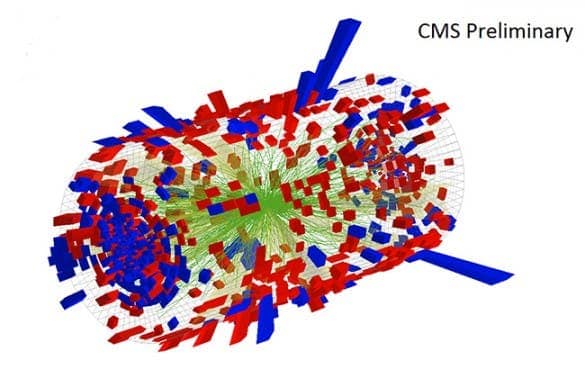Scientists closely working with the Large Hadron Collider, the largest and most powerful particle accelerator in the world, have identified evidence of the minuscule droplets produced in the aftermath of high energy proton and lead ions collisions. If their calculations are right, then these are the smallest droplets of liquid ever encountered thus far, just three to five protons in size. That’s about one-100,000th the size of a hydrogen atom or one-100,000,000th the size of a virus. WOW!
“With this discovery, we seem to be seeing the very origin of collective behavior,” said Julia Velkovska, professor of physics at Vanderbilt who serves as a co-convener of the heavy ion program of the CMS detector, the LHC instrument that made the unexpected discovery. “Regardless of the material that we are using, collisions have to be violent enough to produce about 50 sub-atomic particles before we begin to see collective, flow-like behavior.”

A three-dimensional view of a p-Pb collision that produced collective flow behavior. The green lines are the trajectories of the sub-atomic particles produced by the collision reconstructed by the CMS tracking system. The red and blue bars represent the energy measured by the instrument’s two sets of calorimeters. (CMS Collaboration)
These tiny droplets “flow” in a manner similar to the behavior of the quark-gluon plasma, a state of matter that is a mixture of the sub-atomic particles that makes up protons and neutrons and only exists at extreme temperatures and densities. Some scientists claim that at the very dawn of the Universe’s existence shortly after the big bang, this primordial cosmic goo was everywhere, because of much higher temperature and density conditions.
These interactions weren’t actually targeted for observation by the LHC researchers, though. Scientists were looking to check the validity of their lead-lead results, and scheduled a proton-lead ion collision for as a simply control run – they ended up with quark-gluon plasma in the process.
“The proton-lead collisions are something like shooting a bullet through an apple while lead-lead collisions are more like smashing two apples together: A lot more energy is released in the latter,” said Velkovska.
Indeed, last September LHC researchers found that in five percent of the protons and lead nuclei collisions —those that were the most violent – evidence of collective behavior was encountered. In turn, this allowed for the formation of liquid droplets about one tenth the size of those produced by the lead-lead or gold-gold collisions. The data gathered then, however, wasn’t enough to discount the influence of particle jets. New experiments in January and February of this year resulted in hundreds of cases where the collisions produced more than 300 particles flowing together.
According to doctoral student Shengquan Tuo, who recently presented the new results at a workshop held in the European Centre for Theoretical Studies in Nuclear Physics and Related Areas in Trento, Italy, only two models were advanced to explain their observations at the workshop. Of the two, the plasma droplet model seems to fit the observations best.
The new observations are contained in a paper submitted by the CMS collaboration to the journal Physics Letters B and posted on the arXiv preprint server.
[source]









